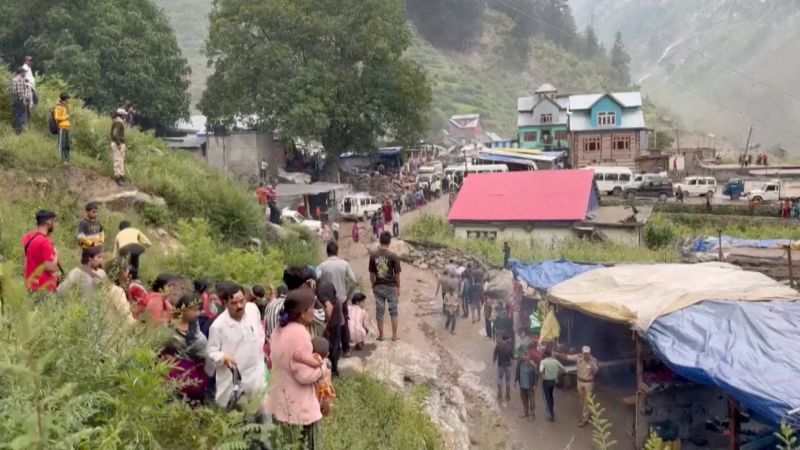Could Heavy Rain in Kashmir Be Behind Dozens of Deaths and Over 200 Missing?

Understanding the Impact of Extreme Weather in the Himalayas
In recent years, extreme weather events have become increasingly frequent in India, particularly in the Himalayan region. The devastating flash floods in India-administered Kashmir are a stark reminder of the vulnerabilities faced by communities living in these mountainous areas. With the recent tragedy in Chashoti, where at least 46 lives were lost and over 200 individuals remain missing, it’s essential to explore the causes, implications, and potential solutions to these alarming weather patterns.
The Tragedy in Chashoti
The picturesque town of Chashoti, a renowned pilgrimage site for Hindu tourists, has been severely impacted by a sudden cloudburst that unleashed torrential rains. These intense downpours led to flash floods that transformed roads into torrents and caused catastrophic damage to infrastructure. Eyewitness accounts describe scenes of chaos, with water, mud, and debris cascading down mountainsides, obliterating buildings and sweeping away vehicles.
Rescue Efforts Underway
In the aftermath of the floods, rescue operations have been initiated with urgency. Local authorities, including army and police personnel, are mobilizing resources in a desperate search for the missing. The Jammu and Kashmir Chief Minister, Omar Abdullah, has emphasized the grim reality of the situation, stating that all available resources are being deployed both locally and from outside regions to assist in rescue efforts.
The Science Behind Cloudbursts
According to India’s Meteorological Department, the extreme rainfall experienced in Chashoti was classified as a “cloudburst.” A cloudburst refers to a sudden and intense rainfall event, typically involving more than 100 mm (4 inches) of rain within a short time frame, often less than an hour. This phenomenon can precipitate devastating flash floods and landslides, particularly in mountainous regions that are already predisposed to such disasters.
The Dangers of Cloudbursts
Cloudbursts pose significant risks to communities in the Himalayas due to their abrupt nature and the terrain's susceptibility to flooding and landslides. The impacts of these weather events can be catastrophic, leading to loss of life, destruction of property, and disruption of essential services. Some of the dangers associated with cloudbursts include:
- Flash Flooding: Rapid accumulation of water can overwhelm drainage systems and lead to swift, life-threatening floods.
- Landslides: Increased rainfall can destabilize slopes, causing landslides that block roads and isolate communities.
- Infrastructure Damage: Buildings, roads, and bridges can be severely damaged or destroyed, complicating rescue and recovery efforts.
Historical Context of Extreme Weather in India
The recent floods in Kashmir are not an isolated incident. Earlier in the month, a similar surge of floodwaters impacted a village in Uttarakhand, claiming at least four lives. These occurrences reflect a broader trend of increasing weather extremes in India, particularly during the monsoon season. The monsoon, while essential for agriculture, has been characterized by erratic patterns, leading to both droughts and severe flooding.
Climate Change and Its Role
The escalation of extreme weather events in India can be partially attributed to climate change. Rising global temperatures are causing shifts in weather patterns, making regions susceptible to unusual weather phenomena. Some contributing factors include:
- Increased Temperature: Global warming leads to higher evaporation rates, resulting in more moisture in the atmosphere.
- Erratic Weather Patterns: Changes in climate can result in unpredictable rainfall, intensifying the likelihood of cloudbursts.
- Rapid Urbanization: Increased construction in vulnerable areas can exacerbate the impact of floods, reducing the land's natural ability to absorb rainwater.
Community Resilience and Preparedness
In light of the recent disasters, it is imperative to focus on building community resilience and preparedness for extreme weather events. Effective strategies may include:
- Early Warning Systems: Implementing advanced meteorological systems can provide timely alerts to communities about impending weather threats.
- Infrastructure Improvement: Developing resilient infrastructure that can withstand extreme weather is crucial for minimizing damage.
- Community Education: Raising awareness about disaster preparedness can empower residents to respond effectively during emergencies.
- Environmental Conservation: Preserving natural landscapes can help mitigate the impacts of flooding and landslides.
Government Response and Policy Implications
The Indian government faces the challenge of responding to the increasing frequency of extreme weather events. Effective policy responses are essential for managing disaster risk and enhancing community resilience. Key areas for government focus may include:
- Disaster Management Planning: Developing comprehensive plans that encompass prevention, preparedness, response, and recovery phases is critical.
- Investment in Infrastructure: Allocating resources for building and maintaining resilient infrastructure can help protect vulnerable communities.
- Climate Adaptation Strategies: Implementing policies that address the impacts of climate change can reduce the vulnerability of communities.
Conclusion
The flash floods in Chashoti serve as a tragic reminder of the vulnerabilities faced by communities in the Himalayas. As extreme weather events become more frequent, it is crucial for governments, communities, and individuals to work collaboratively to enhance resilience. By investing in disaster preparedness, improving infrastructure, and addressing the impacts of climate change, we can better protect lives and livelihoods in these vulnerable regions.
Frequently Asked Questions
What is a cloudburst?
A cloudburst is a sudden, intense rainfall event that can lead to flash floods, particularly in mountainous regions. It typically involves more than 100 mm of rain in a very short period, which can cause significant damage.
How can communities prepare for flash floods?
Communities can prepare for flash floods by implementing early warning systems, enhancing infrastructure, conducting public education campaigns, and developing disaster management plans.
What role does climate change play in extreme weather?
Climate change contributes to extreme weather patterns by increasing temperatures and altering precipitation trends, which can lead to more frequent and intense weather events such as floods and droughts.
As we witness the ongoing impacts of climate change and extreme weather, what measures do you think should be prioritized to protect vulnerable communities in the Himalayas and beyond? #ClimateChange #DisasterManagement #Himalayas
```Published: 2025-08-15 04:48:53 | Category: Trump GNEWS Search



